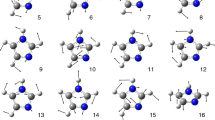Abstract
The kinetic and thermodynamic characteristics of solid-phase ligand substitution reactions were determined for chromium(III) and cobalt(III) amine complexes with B10H 2−10 and C2B9H −12 in the outer sphere. The kinetic equation of the topochemical process was found to be of the formf(α)=(1−α)2/3, corresponding to a reaction proceeeding on the interface between the phases (shrinking sphere). Two types of solid-phase ligand substitution reactions were found: endothermic and exothermic reactions taking place either through thermal activation of the metal-ligand bond (in substitution reactions by the anion B10H 2−10 ), or through the acid-base proton-exchange reaction between the anion C2B9H −12 entering the coordination sphere and the amine leaving it; in this case the process proceeds without mass loss. It could be demonstrated that the reactions occurring in crystalline complex salts cannot proceed by purely dissociative or associative mechanisms; depending on the structure of the crystal lattice, mutually adapted dissociative or associative mechanisms are feasible. Reactions proceeding by the first mechanism haveE a=300–500 kJ/mol and logA=30–50; the values for reactions proceeding by the second mechanism areE a= =180–250 kJ/mol and logA=15–25.
Zusammenfassung
Die kinetischen und thermodynamischen Kennwerte der Ligandensubstitutionsreaktionen in fester Phase bei Chrom(III)- und Kobalt(III)-Aminkomplexen mit B10H 2−10 und C2B9H12/− als Anionen in der externen Sphäre wurden untersucht. Die kinetische Gleichung des topochemischen Prozesses hat die Formf(α)=(1−α)2/3, was einer an der Grenzfläche zwischen zwei Phasen verlaufenden Reaktion entspricht. Zwei Typen von Ligandsubstitutionsreaktionen in fester Phase wurden gefunden: endotherme und exotherme Reaktionen verlaufen entweder infolge thermischer Aktivierung der Metall-Ligand-Bindung (in Substitutionsreaktionen des Anions B10H 2−10 ) oder durch Protonenaustausch zwischen dem in die Koordinationssphäre eintretende Anion C2B9H −12 und dem daraus austretenden Amin; in diesem Falle verläuft der Prozeß ohne Massenverlust. Es konnte gezeigt werden, daß die in kristallinen Komplexsalzen vor sich gehenden Reaktionen nicht nach einem rein dissoziativen oder assoziativen Mechanismus verlaufen können; abhängig von der Struktur des Kristallgitters ist ein wechselseitig angepasster dissoziativer oder assoziativer Mechanismus wahrscheinlich. Die nach dem ersten Mechanismus verlaufenden Reaktionen weisen fürE a Werte von 300 500 kJ/mol und für logA von 30–50 auf, während bei nach dem zweiten Mechanismus verlaufenden Reaktionen die entsprechenden Werte zwischen 180 und 250 kJ/mol bzw. 15 und 25 liegen.
Резюме
Измерены кинетическ ие и термодинамическ ие характеристики твер дофазных реакций замещения ли гандов в аминных комп лексах хрома(Ш) и кобальта(Ш) бо рогидридными анионами B10H 2-10 и C2B9 H 12/- во вн ешней сфере. Найдено, что для изученных реа кций кинетическое уравне ние топохимического процесса имеет видf(α)=(1-а)2/3, что соответствует разви тию реакции на межфаз ной границе (сжимающаяся сфера).
Установлены два типа твердофазных реакци й замещения лигандов: реакции с эн до- и экзотермическим эфф ектом, которые могут осуществляться либо за счет термической активации связи мета лл-лиганд (реакция зам ещения анионом B10H 2-10 ), либо за сче т кислотно-основной ре акции обмена протоно м между вступающим в координ ационную сферу анионом С2В9Н -12 и уходящим амином; прич ем процесс протекает бе з потери массы.
Показано, что чисто ди ссоциативный или чис то ассоциативный механ измы для реакций в кристаллических ко мплексных солях не ре ализуются. В зависимости от строе ния кристаллической решетки соли возможн ы диссоциативный или ассоциативный взаим осогласованные механизмы. Реакции, пр отекающие по первому механизму, будут иметь величиныЕ a =300–500 кДж/моль и logA=30–50, по в торому −Еina=180–250 кДж/моль и logА=15–25.
Similar content being viewed by others
References
T. J. Marks and J. R. Kolb, Chem. Rev., 77 (1977) 263.
N. N. Greenwood and M. Ward, Chem. Soc. Rev., 3 (1974) 231.
A. Davison, D. D. Traficante and S. S. Wreford, J. Am. Chem. Soc., 96 (1974) 2802.
N. F. Curtis, J. Chem. Soc., (1965) 964.
Yu. N. Shevchenko, N. K. Davidenko, R. A. Svitsin, N. I. Yashchina and N. B. Egorova, Zh. Neorg. Khim., 25 (1980) 2180.
Yu. N. Shevchenko, N. I. Yashchina, R. A. Svitsin and N. V. Egorova, Zh. Obshch. Khim., 51 (1981) 1258.
Yu. N. Shevchenko and N. I. Yashchina, Zh. Obshch. Khim., 51 (1981) 2582.
Yu. N. Shevchenko, N. I. Yashchina, K. B. Yatsimirsky, R. A. Svitsin and N. B. Egorova, Zh. Neorg. Khim., 28 (1983) 416.
Yu. N. Kukushkin, V. F. Budanova and G. N. Sedova, Thermal transformations of coordination compounds in the solid phase, Izv. Leningradskogo Universiteta, Leningrad, 1981, p. 176 (in Russian).
V. A. Logvinenko, Thermal analysis of coordination compounds and clathrates, Izd. Nauka, Sibirian Division, Novosibirsk, 1982, p. 128 (in Russian).
L. J. Todd, Metalloborone derivatives with ligand-metal single bonds, Inorg. Compounds with Unusual Properties, Washington, D. D., 1976, p. 302 (in Russian).
R. D. Dobrott and W. N. Lipscomb, J. Chem. Phys., 37 (1962) 1779.
R. Grimes, Carboranes, Izd. Mir, Moscow, 1974, p. 264 (Russian translation).
A. A. Fotiev and V. V. Mochalov, Zh. Neorg. Khim., 13 (1968) 3174.
A. F. Zatsepin, A. A. Fotiev and I. A. Dimtriev, Zh. Neorg. Khim., 18 (1973) 2883.
F. Bassolo and R. Pearson, Mechanisms of inorganic reactions, Izd. Mir, Moscow, 1971, p. 592 (Russian translation).
E. Zirngiebl and A. Burger, USA, Pat. No. 3.298.798.
Yu. N. Shevchenko, N. K. Davidenko, K. B. Yatsimirsky, R. A. Svitsin and V. S. Khain, Izv. AN SSSR, Neorg. materiali, 14 (1978) 1747.
Yu. N. Shevchenko and N. I. Yashchina, Zh. Neorg. Khim., 27 (1982) 1441.
A. F. Kapustinsky and K. B. Yatsimirsky, Zh. Obshch. Khim., 26 (1956) 941.
V. N. Kondrateva, Splitting energies of chemical bonds. Ionization potentials and electron affinity, Izd. Nauka, Moscow, 1974, p. 351 (in Russian).
Yu. N. Shevchenko, Synthesis and investigation of cobalt(III) and chromium(III) amine complexes, Abstract of thesis for the C. Sc. degree, Kiev, 1977, p. 27 (in Russian).
Author information
Authors and Affiliations
Additional information
The authors are grateful to F. G. Szabó (ETALON Factory, Baku) for help in the application of the derivatograph for quantitative measurements and for development of a method to record thermoanalytical curves for measuring enthalpies of reactions.
Rights and permissions
About this article
Cite this article
Yashina, I.I., Shevchenko, Y.N. Solid-phase ligand substitution reactions by borohydride anions in chromium(III) and cobalt(III) amine complexes. Journal of Thermal Analysis 30, 319–329 (1985). https://doi.org/10.1007/BF02156497
Received:
Issue Date:
DOI: https://doi.org/10.1007/BF02156497




